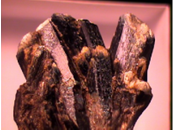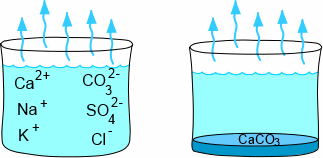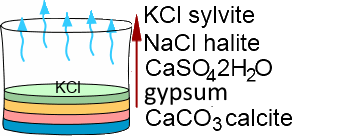





The major processes that lead to the formation of minerals are: · Crystallization of a liquid by cooling from liquid to solid state. Examples: passage of water to ice; crystallisation by cooling of a magma. ·Chemical precipitation from a supersaturated mineral solution. Examples: the formation of agates; the formation of deposits of caverns, minerals of the evaporite sequence. · Crystallization of vapor. Example: the crystallization of sulfur around fumaroles (emissions of $H_2S$ rich gas from the magma chamber) on volcanoes.
Each mineral has its melting point, which also corresponds to its crystallization point at a given pressure. Several minerals in the crust crystallize from a magma, that is to say, molten rock. This crystallization obeys certain rules. In a magma having a temperature greater than 1200 ° C, as at the top mantle of the earth, for example, minerals are in their liquid phase. If magma is introduced into the crust, it undergoes a pressure reduction and gradually cools. With a lowering of the temperature of the magma, minerals crystallize, when their crystallization temperature becomes gradually low. The order of crystallization is as follows: 1) Olivine. 2) Pyroxenes. 3) Amphiboles 4) Biotite. 5) Quartz 6) Feldspar 7) Muscovite
Olivine

A pyroxene: augite

An amphibole : hornblende

Biotite

A feldspar

Muscovite

As minerals crystallize in the magma chamber ie in the pocket where the magma is introduced, the crystals settle out and accumulate at the base of the chamber. It is therefore a segregation, and rocks from the crystallization of magma (igneous rocks) will have different mineral assemblages in the basis, in the middle or at the top of the magma chamber.

There are all kinds of aqueous solutions circulating in the rocks of the crust. They can originate from the hot zones and the mantle by an excess of water vapor from a magma. Or it may be water which had been trapped in the deep sedimentary basins. The beautiful agates that are sold in mineral stores were formed by the precipitation of minerals from a solution in a rock cavity.

The water comes from the surface by infiltration through fractures of limestone. Upon the dissolution of limestone (1) .. $Ca^{2+}CO_3^{2-}$ $+$ $H_2O$ $+$ $CO_2$ $\rightarrow$ $Ca^{2+}$ $+$ $2HCO_3^{-} $ ..the water takes up $CO_2$, calcium ions ($Ca^{2+}$) and hydrogencarbonate ions $HCO_3^{-}$. In rocks just above the cave, the pressure of $CO_2$ contained in the solution is several atmospheres, because of the weight of the rock. When the solution seeps into the cave, its pressure decreases suddenly. This produces the phenomenon of degassing of $CO_2$: $Ca^{2+}$ $+$ $2HCO_3^{-}$ $\rightarrow$ $Ca^{2+}CO_3^{2-}$ $+$ $H_2O$ $+$ $CO_2$ Calcite $CaCO_3$ precipitates, one observes the formation of stalactites (2) and stalagmites (3).

Seawater contains a large range of ions in solution, positive ions such as calcium, sodium and potassium, negative ions as the chloride, carbonate and sulfate ions. Only water is evaporated, which means that as evaporation proceeds the salts are getting more concentrated. Sea water is slightly supersaturated with respect to calcium carbonate, $CaCO_3$. This precipitates first and deposits a layer of $CaCO_3$ crystals (calcite or aragonite) at the bottom of the jar.

With further evaporation and therefore an increase in salinity, the solution becomes supersaturated with respect to another salt, $CaSO_4$ hydrate (gypsum); the solution (the medium) is called penesaline. The gypsum precipitates. Then, with a further increase in salinity, the next precipitation step is sodium chloride, NaCl (halite, common salt). Now the solution (the middle) is called saline.

The last phase before complete evaporation concerns potassium chloride, KCl (sylvite, commonly known as potash); the solution (the medium) is hypersaline. We thus obtain a very specific sequence of mineral precipitates as the evaporation of seawater proceeds. They are evaporites.

In nature, precipitation of evaporite minerals happens, among other things, in large lagoons in the sea, lagoons that are measured in tens or hundreds of square kilometers in areas where evaporation exceeds precipitation.